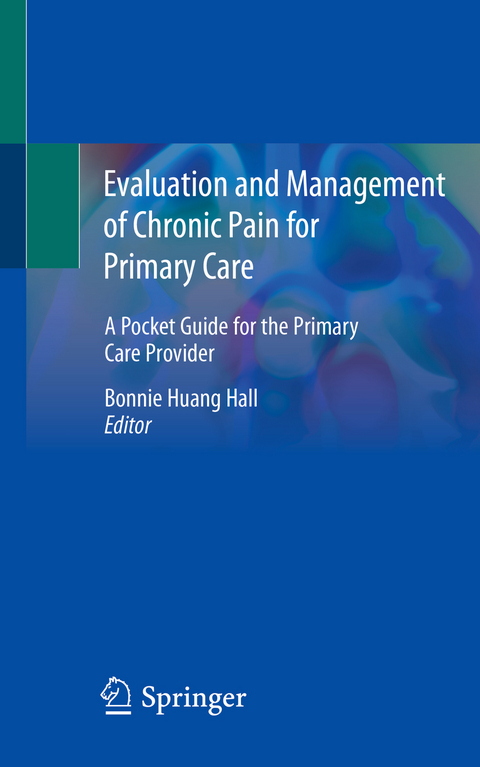
Evaluation and Management of Chronic Pain for Primary Care
Springer International Publishing (Verlag)
978-3-030-47116-3 (ISBN)
Primary care physicians are often the first caretakers to whom patients present for chronic pain. The current literature targeted at these providers is sparse, and the existing literature is very broad and large in scope and size. There are no quick pocket guides on this topic that the general practitioner may use as a point of care reference. This first of its kind text provides a practical, hands-on approach to the evaluation and treatment of chronic pain in the family medicine setting.
Divided into four main sections, the first part focuses on the general approach to any patient suffering from chronic pain. Chapters in this section include the physical exam, formulating a diagnosis, formulating a variety of treatment plans including medication, physical therapy and psychiatric therapy, and specialist referral, among others. The second section focuses on evaluation and management of the chronic pain patient who requires opioid therapy. Thissection includes useful guidance on how to convert into morphine equivalents, interpretation of urine drug tests, and helpful office procedures for managing refills. It gives practical guidance on how to prescribe opioid reversal agents and opioid tapering regimens. A systems based approach to managing the patient is also discussed. The third section informs the reader of viable alternative and complementary treatment options. Five main treatment types are discussed each with their own separate chapter. These include musculoskeletal-based therapy, medicinal therapies, sense-based therapy, relaxation-based therapy and physical/exercise-based therapy. Given the controversy and limited training primary care physicians have on marijuana and cannabis, one chapter is dedicated specifically to inform the primary care physician on marijuana as a medicinal therapy for chronic pain. The fourth section focuses entirely on myofascial pain and trigger point therapy. The chapters in this section teach the reader how to examine and diagnose myofascial pain and distinguish between fibromyalgia. They also provide general principles of myofascial trigger point therapy and how to practically perform these in sthe clinical setting. Topics discussed include: trigger point massage, cold and stretch, isometric contraction, trigger point injection, and ischemic compression. It also includes general instruction so that the practitioner can teach patients how to perform trigger point therapy easily in their own home. The last chapter details chronic myofascial back pain and how to examine and practically treat with trigger point therapies.
Evaluation and Management of Chronic Pain is a first-of-its-kind pocket-guide text specifically designed for primary care providers. It also appeals to residents, medical students and any other professional interested in treating chronic pain.
Dr. Bonnie Huang Hall is a board certified family physician with an interest in chronic pain and in particular, myofascial pain. She obtained an MD-PhD from Robert Wood Johnson Medical School and Rutgers University in New Jersey, her home state. Originally, she aspired to be a surgeon, but after a year in internal medicine preliminary residency, she was surprised that so many patients did not want surgery. During her training, she also realized the critical role that primary care plays in the U.S. healthcare system. Consequently, she completed a family medicine residency at UCSF-Natividad Medical Center in Salinas, CA. Following that, she completed a Stanford associated OBGYN fellowship at Santa Clara Valley Medical Center, in San Jose. During those times, she encountered the pain epidemic and decided to take on the challenge of thoroughly taking care of these complicated patients. She served on various pain committees in her professional life including at North East Medical Services and at the County of Monterey. After starting her own private practice, she also made a realization that many people do not want conventional western medication. Consequently, she embarked on learning about natural treatments for pain and other diseases. She is a volunteer Assistant Clinical UCSF professor in the department of family and community medicine and enjoys teaching and writing for the benefit of the medical community.
Introduction.- Part 1 GENERAL EVALUATION AND MANAGEMENT OF CHRONIC NONCANCER PAIN.- Chapter 1 History Taking for Chronic Pain.- Chapter 2 Physical Examination for Chronic Pain.- Chapter 3 Diagnostic Evaluation for Chronic Pain.- Chapter 4 Specialist Evaluation for Chronic Pain.- Chapter 5 Formulating a Diagnosis for Chronic Pain.- Chapter 6 Management of Chronic Pain: Medication.- Chapter 7 Management of Chronic Pain: Nonpharmacological and Multidisciplinary approach.- Pat 2 THE OPIOID REQUIRING PATIENT.- Chapter 8 The Opioid Requiring Patient: Evaluation and Management.- Chapter 9 The Opioid Requiring Patient: Office Level Management.- Chapter 10 The Opioid Requiring Patient: Systems Level Management.- Chapter 11 Implementing and following a safe and compassionate opioid-prescribing policy.- Part 3 COMPLEMENTARY AND ALTERNATIVE MEDICINE AND CHRONIC NONCANCER PAIN.-Introduction to Complementary and Alternative medicine.- Chapter 12 Manipulative Therapies for Chronic Pain.- Chapter 13 Energy based Therapies for Chronic Pain.- Chapter 14 Medical Marijuana for Chronic Pain.- Chapter 15 Medicinal Therapies for Chronic Pain.- Chapter 16 Exercise or Movement based Therapies for Chronic Pain.- Chapter 17 Mental based Therapies for Chronic Pain.- Part 4 CHRONIC MYOFASCIAL PAIN.- Chapter 18 Chronic Myofascial Pain, Fibromylagia, and Myofascial Trigger Points.- Chapter 19 Treatment principles of myofascial pain syndrome.- Chapter 20 Example Myofascial Pain Case: Quadratus lumborum trigger point and chronic low back pain.
| Erscheinungsdatum | 04.07.2020 |
|---|---|
| Zusatzinfo | XXI, 279 p. |
| Verlagsort | Cham |
| Sprache | englisch |
| Maße | 127 x 203 mm |
| Gewicht | 369 g |
| Themenwelt | Medizin / Pharmazie ► Gesundheitswesen |
| Medizin / Pharmazie ► Medizinische Fachgebiete ► Schmerztherapie | |
| Medizin / Pharmazie ► Naturheilkunde | |
| Schlagworte | alternative treatments • chronic pain • Medicinal therapies • Musculoskeletal • myofascial pain • physical therapy • psychiatric therapy • Relaxation based therapy • Sense based therapy |
| ISBN-10 | 3-030-47116-0 / 3030471160 |
| ISBN-13 | 978-3-030-47116-3 / 9783030471163 |
| Zustand | Neuware |
| Haben Sie eine Frage zum Produkt? |
aus dem Bereich


